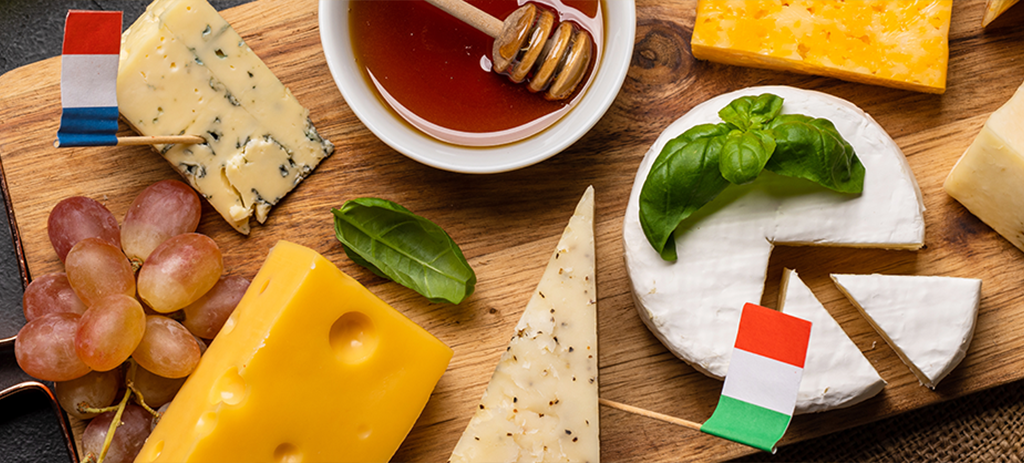The art of cheese making is more than 8000 years old and there are more than 1800 types of cheese made worldwide. Nearly every cheese starts with the same four ingredients: milk, a dash of salt, culture, and enzyme. Varieties include blue cheese, hard cheese, pasta filata, smoked cheese, medium-hard, semi-soft, fresh cheese, and flavoured cheeses.
Fresh Cheese

Fresh cheese is unaged, unripened, rindless, and has the same bright, white colour on the inside and out. Fresh cheeses are made to be eaten as soon as they’ve been made, so there’s no need to let them age or mature whatsoever. Because of this, they still contain a lot of moisture, so don’t last anywhere near as long as drier, firmer cheeses. Since fresh cheese has a high moisture content, it can be easily rolled in to various herbs, spices, nuts, or cuts of fruit.
Fresh Cheese Find it here.
Hard Cheese

The majority of British cheeses fall into this category. Almost all our historic varieties – known as territorials – are made in this way. The cheese is pressed after being made to remove as much moisture as possible. The cheese can be pressed and then matured for anything from one month to over two years, allowing for a huge variety of textures and flavours.
Younger hard cheeses tend to be crumblier in texture with a fresh, lactic and lemony flavour (think Wensleydale or Cheshire). More mature varieties develop salt crystals, making them crunchy and more savoury (like cheddar and Old Winchester Cheese). All types of milk are used to make hard cheeses. As well as being pressed, some varieties are bound in cloth, aged in caves, blended with herbs and even smoked.
Hard Cheese Find it here.
Soft Cheese

This category is traditionally associated with France, the birthplace of Brie and Camembert – two of the world’s most famous soft cheeses.
Like fresh cheeses, soft varieties have a high moisture content, but have been allowed to ripen and mature so they can develop a more complex flavour. The curds are left to settle rather than being pressed. They almost always develop a ‘bloomy’ rind, which is created by spraying a mould such as pennicillium candidum or penicillium camemberti over the surface.
The bacteria in the rind slowly breaks down the fats and proteins in the cheese, resulting in a creamy, runny centre. While most soft cheeses are made in a similar way to Brie or Camembert, there are some more unusual varieties. These are usually made with goat’s milk and come in the form of a log, are rolled in ash or flavoured with spices.
Soft Cheese Find it here.
Semi-Soft Cheese

There are a number of modern artisan cheeses that sit between soft and hard in terms of texture. Naturally, these fit into the semi-soft (also known as semi-hard) category. They tend to have either a rubbery texture (such as the nettle leaf-wrapped Cornish Yarg) or are more similar to soft, bloomy rind cheeses, with a centre that’s still smooth and creamy.
Washed-rind cheeses tend to fall into the semi-soft category. These are cheeses that have been treated with a brine or alcohol during the maturation process. This results in amazing rinds full of colour and texture as well as a particularly pungent smell (Epoisses & Stinking Bishop are two of most famous examples). However, they usually taste much milder than their aroma suggests. It’s the rind that delivers the more complex smell and flavour.
Semi-Soft Cheese Find it here.
Blue Cheese

Blue cheese is the most complex of all cheeses. It’s rich and creamy like soft cheese, yet pungent and perfumed like hard cheese. While some people are put off by the look, flavour or just the idea of blue cheese, many more are obsessed with its incredible taste and texture. Any of the above styles of cheese can be turned blue with the injection of penicillium roqueforti – a type of mould that’s either sprayed or injected into cheese during production. The bacteria begin to affect proteins in the cheese, resulting in the appearance of green, blue-grey or blue pieces of mould.
The most famous British blue is of course Stilton. But there are many other varieties now available, made using all types of milk and ranging from soft to hard. While it is one of the most difficult cheeses to produce (the introduction of the mould means blues must be aged or matured in strictly controlled conditions) it also results in some of the most amazing flavours found in British cheese.
Blue Cheese Find it here.
Discovering Different Types of Cheese Around the World

What’s the difference?
Europe boasts a rich tapestry of cheese variations, each with its unique flavours, textures. Our European cheese-making heritage is a testament to centuries of craftsmanship, showcasing the diversity and artistry that define each region’s contribution to this beloved culinary tradition.
French Cheese
France, known as the “cheese capital” of the world, offers an extensive array, from the pungent Roquefort to the creamy Brie. The production of these cheeses involves meticulous processes, including curdling milk, draining whey, and aging. Goat’s milk is also renowned for its rich and creamy texture, imparting a distinctively delicate and tangy flavour to a variety of artisanal cheeses

Italian Cheese
Italy, famous for Parmesan and mozzarella, employs time-honoured techniques like brining and aging in wooden barrels. Parmesan, with its nutty and savoury profile, graces dishes with a bold flavour, while creamy and delicate Gorgonzola adds a luxurious touch to salads and pastas, showcasing the diverse and rich tapestry of Italian cheeses.

Italian Cheese Find it here.
Spanish Cheese
Spanish cheeses offer a delightful diversity, ranging from the creamy and mild Manchego to the piquant intensity of Cabrales, showcasing the country’s rich culinary heritage and regional variations. In Spain, the celebrated Manchego undergoes a distinct sheep’s milk fermentation and maturation process that produces it’s iconic flavour.

Spanish Cheese Find it here.
Greek Cheese
Greek cheese is influenced by centuries-old traditions, local agricultural practices, and the unique Mediterranean climate, resulting in a rich and diverse array of flavours and textures. In Greece, feta stands out as a quintessential contribution to the European cheese scene. Crafted from sheep’s milk, feta undergoes a process of brining that imparts its distinctive tangy taste and crumbly texture.

Greek Cheese Find it here.
British Cheese
From classic Blue Cheese and Cheddars through to new and exciting Beauvale soft cheese, the rise of quality British cheese is showing no signs of letting up and that’s good news for us all! The production of British cheeses is a rich and diverse tradition, showcasing a wide array of flavours and textures that include; tangy Stiltons and smooth, creamy Cornish Yarg, reflecting the country’s longstanding expertise in dairy craftsmanship.

British Cheese Find it here.
How Many Types of Cheese Are There?
Cheese is an ancient ingredient that’s prepared in different ways by cultures all over the world, so it’s difficult to estimate how many types of cheese there are. We can say for sure that there are thousands of types of cheese; in the country of France alone, some people estimate that there are over 1,000 distinct varieties of cheese, and there are almost as many ways of classifying them!
Food Pairing
The only rule of cheese pairing is that there are no rules. Your taste buds are truly your best guide and even the most unlikely pairings will delight some cheese lovers. For beginner’s, pairing items from the same geographic region that share the same terroir, will likely pair well together.
Whether you are a novice cheese aficionado, or an experienced cheesemonger, the pairing of vegetables, fruit, or wine is all about personal choice. Which is why Cheese is one of the world most beloved foods.

